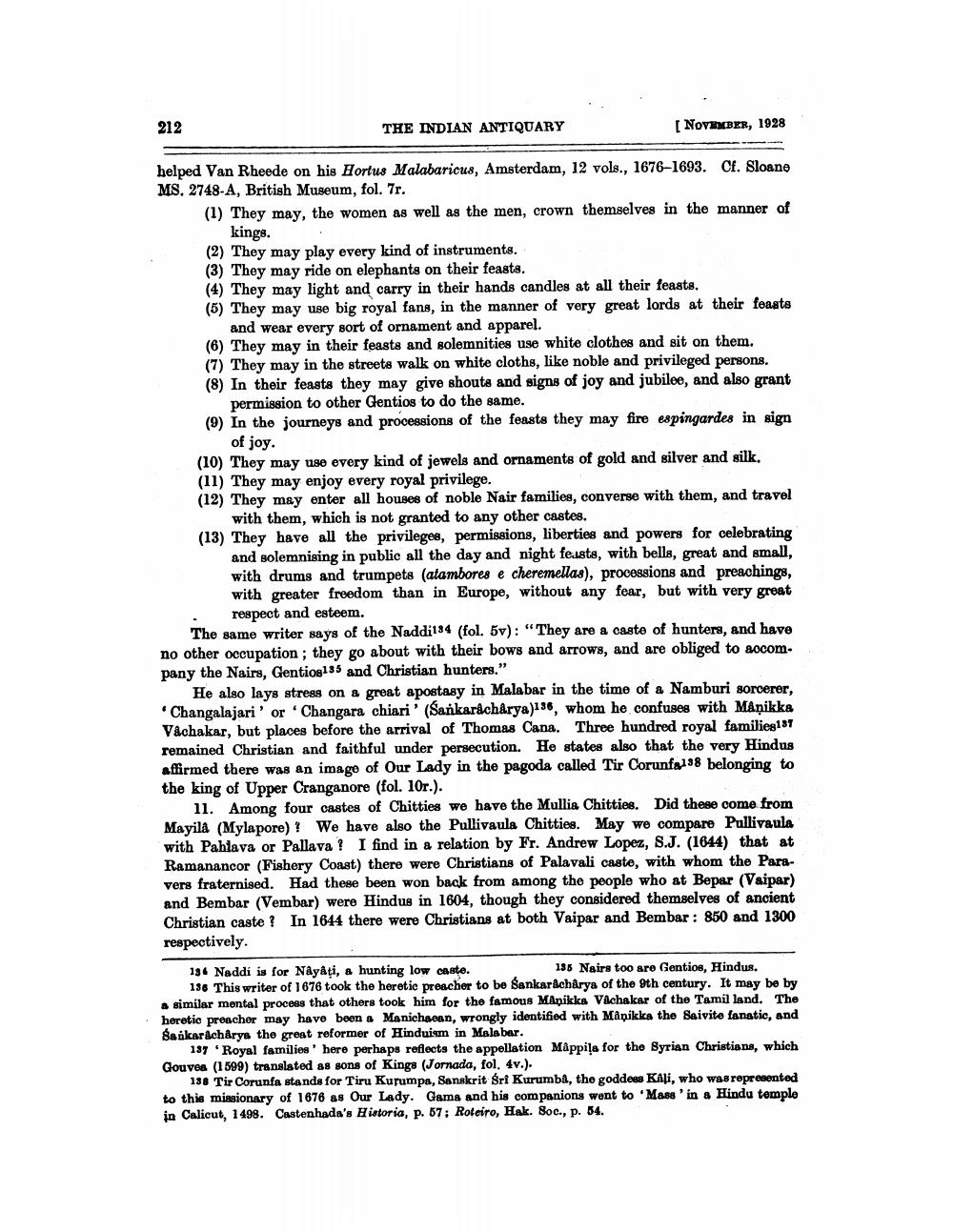________________
212
THE INDIAN ANTIQUARY
[ NOVEMBER, 1928
(13) Thes
helped Van Rheede on his Hortus Malabaricus, Amsterdam, 12 vols., 1676-1693. Cf. Sloane MS, 2748-A, British Museum, fol. 7r.
(1) They may, the women as well as the men, crown themselves in the manner of
kings. (2) They may play every kind of instruments. (3) They may ride on elephants on their feasts. (4) They may light and carry in their hands candles at all their feasts. (5) They may use big royal fans, in the manner of very great lords at their feasts
and wear every sort of ornament and apparel. (6) They may in their feasts and solemnities use white clothes and sit on them. (7) They may in the streets walk on white cloths, like noble and privileged persons. (8) In their feasts they may give shouts and signs of joy and jubilee, and also grant
permission to other Gentios to do the same. (9) In the journeys and processions of the feasts they may fire espingardes in sign
of joy. (10) They may use every kind of jewels and ornaments of gold and silver and silk. (11) They may enjoy every royal privilege. (12) They may enter all houses of noble Nair families, converse with them, and travel
with them, which is not granted to any other castes. They have all the privileges, permissions, liberties and powers for celebrating and solemnising in public all the day and night feasts, with bells, great and small, with drums and trumpets (atambores e cheremellas), processions and preachings, with greater freedom than in Europe, without any fear, but with very great
respect and esteem. The same writer says of the Naddi184 (fol. 5v): "They are a caste of hunters, and have no other occupation; they go about with their bows and arrows, and are obliged to socom pany the Nairs, Gentios135 and Christian hunters."
He also lays stress on a great apostasy in Malabar in the time of a Namburi sorcerer, Changalajari' or Changara chiari' (Sankaracharya)136, whom he confuses with Manikka Vachakar, but places before the arrival of Thomas Cana. Three hundred royal families187 remained Christian and faithful under persecution. He states also that the very Hindus affirmed there was an image of Our Lady in the pagoda called Tir Corunfs 138 belonging to the king of Upper Cranganore (fol. 10r.).
11. Among four castes of Chitties we have the Mullia Chitties. Did these come from Mayila (Mylapore)! We have also the Pullivaula Chitties. May we compare Pullivaula with Pahlava or Pallava ! I find in a relation by Fr. Andrew Lopez, S.J. (1644) that at Ramanancor (Fishery Coast) there were Christians of Palavali caste, with whom the Paravers fraternised. Had these been won back from among the people who at Bepar (Vaipar) and Bembar (Vembar) were Hindus in 1604, though they considered themselves of ancient Christian caste? In 1644 there were Christians at both Vaipar and Bembar : 850 and 1300 respectively. 136 Naddi is for Nayați, a hunting low caste.
136 Nairs too are Gentios, Hindus. 136 This writer of 1676 took the heretic preacher to be Sankarachårys of the 9th century. It may be by a similar mental process that others took him for the famous MAņikks Vâchakar of the Tamil land. The heretio proncher may have been Manichaoan, wrongly identified with Mapikka the Saivite fanatic, and Bankaracharya the great reformer of Hinduism in Malabar.
187 Royal families' here perhaps reflects the appellation Mappila for the Syrian Christians, which Gouves (1599) translated as sons of Kings (Jornada, fol. 4v.).
188 Tir Corunfa stands for Tiru Kurumpa, Sanskrit Sri Kurumba, the goddess Kali, who was represented to this missionary of 1676 as Our Lady. Gama and his companions went to 'Mass'in a Hindu temple in Calicut, 1498. Castenhada's Historia, p. 67; Roteiro, Hak. Soc., p. 34.




